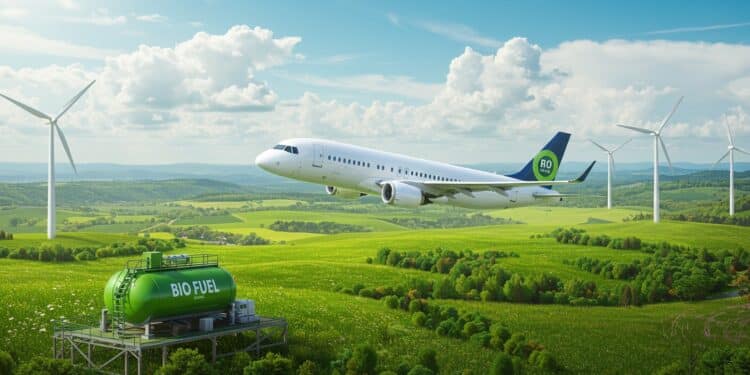Comment concilier les ambitions climatiques de l’Union européenne avec les réalités pratiques du secteur aérien ? Alors que l’UE impose aux compagnies aériennes des objectifs stricts pour intégrer des carburants durables, un obstacle majeur se dresse : la disponibilité limitée de ces carburants. Cette tension entre aspirations écologiques et contraintes techniques soulève une question cruciale : les cibles fixées sont-elles réellement atteignables ? Plongeons dans ce débat qui touche à la fois l’avenir de l’aviation et la lutte contre le changement climatique.
Les Défis de la Décarbonation dans l’Aviation
L’Union européenne a fixé des objectifs ambitieux pour réduire l’empreinte carbone du secteur aérien, responsable de près de 3 % des émissions mondiales de CO2. Ces mesures s’inscrivent dans un effort global pour atteindre la neutralité carbone d’ici 2050. Mais les compagnies aériennes font face à un défi de taille : le carburant d’aviation durable (SAF), fabriqué à partir de ressources comme l’huile de cuisson ou les graisses animales, reste rare et coûteux. Ce carburant est pourtant essentiel pour réduire les émissions par rapport au kérosène traditionnel.
Le cadre réglementaire européen impose une montée en puissance progressive de l’utilisation des SAF : 2 % dès cette année, 6 % en 2030, et un objectif impressionnant de 70 % d’ici 2050. Ces chiffres traduisent une volonté forte, mais la réalité est moins encourageante. Une étude récente révèle que la production actuelle de carburants durables est 30 % inférieure aux besoins pour atteindre l’objectif de 2030. Comment, dans ces conditions, les compagnies aériennes peuvent-elles respecter ces exigences sans bouleverser leurs opérations ?
Une Production de Carburant Durable Insuffisante
Le principal frein à la décarbonation de l’aviation réside dans la faible disponibilité des carburants durables. Produire ces biocarburants à grande échelle demande des infrastructures complexes et des ressources abondantes, deux éléments qui manquent cruellement aujourd’hui. Les compagnies aériennes se retrouvent dans une situation paradoxale : elles doivent se conformer à des réglementations strictes tout en dépendant d’une ressource rare et onéreuse.
Les objectifs de l’UE sont ambitieux, mais leur faisabilité est remise en question par le manque de carburant durable disponible.
Certains transporteurs, pour respecter les quotas imposés, importent des carburants durables de l’extérieur de l’UE. Cette pratique, bien qu’elle permette de répondre aux exigences réglementaires, augmente l’empreinte carbone liée au transport de ces carburants. Une ironie qui souligne l’absurdité de la situation : comment promouvoir une aviation verte si les solutions elles-mêmes génèrent des émissions supplémentaires ?
Des Objectifs Trop Ambitieux ?
Willie Walsh, directeur général de l’Association internationale du transport aérien (Iata), n’a pas mâché ses mots. Selon lui, les objectifs européens sont irréalistes compte tenu des capacités actuelles de production. Il appelle à une réévaluation des cibles, en les alignant sur les volumes de carburants durables réellement disponibles. Cette position reflète une préoccupation croissante dans l’industrie : sans un approvisionnement suffisant, les compagnies aériennes risquent de se retrouver dans une impasse.
Walsh propose une approche plus pragmatique : fixer des objectifs en fonction des capacités de production actuelles et prévues. Une telle stratégie permettrait d’éviter des pénalités pour les compagnies aériennes tout en encourageant les investissements dans la production de SAF. Mais cette suggestion soulève une autre question : l’UE peut-elle se permettre de ralentir ses ambitions climatiques sans compromettre ses engagements globaux ?
Les étapes clés des objectifs européens :
- 2025 : 2 % de carburant durable dans le mélange.
- 2030 : 6 % de carburant durable requis.
- 2050 : Objectif de 70 % de carburant durable.
Neutralité Carbone : Un Horizon Toujours Possible ?
Malgré les obstacles, l’industrie aérienne reste engagée envers l’objectif de neutralité carbone d’ici 2050. Cet engagement, partagé par l’Iata et de nombreux acteurs du secteur, repose sur une combinaison de solutions : amélioration de l’efficacité énergétiquethe aviation sector faces significant challenges in achieving decarbonation due to the limited availability and high cost of sustainable aviation fuel (SAF). The European Union has set ambitious targets for airlines to progressively increase their use of SAF, but industry leaders argue these goals are unrealistic given current production constraints. This article explores the complexities of these regulations, the feasibility of the EU’s targets, and the broader implications for the aviation industry’s path to net-zero emissions by 2050. ### The Challenges of Decarbonation in Aviation The aviation sector contributes nearly 3% of global carbon dioxide emissions, making it one of the most challenging industries to decarbonize. The EU has introduced regulations requiring airlines to incorporate sustainable aviation fuels—biofuels derived from plant and animal materials, such as used cooking oil, which produce fewer emissions than traditional jet fuel. These fuels are seen as critical to meeting emission reduction goals, but their limited availability poses a significant hurdle. The EU’s regulatory framework mandates a gradual increase in SAF usage: 2% starting this year, 6% by 2030, and an ambitious 70% by 2050. However, a recent study indicates that current SAF production falls 30% short of the levels needed to meet the 2030 target. This gap raises concerns about the practicality of these requirements and their impact on airline operations. ### Insufficient Production of Sustainable Fuel The primary obstacle to aviation decarbonation is the limited supply of sustainable fuels. Producing SAF on a large scale requires complex infrastructure and abundant raw materials, both of which are currently in short supply. Airlines face a dilemma: they must comply with stringent regulations while relying on a scarce and expensive resource. > The EU’s targets are ambitious, but their feasibility is questioned due to the lack of available sustainable fuel. Some airlines are resorting to importing SAF from outside the EU to meet quotas, a practice that increases the carbon footprint due to transportation emissions. This irony highlights a flaw in the current approach: how can aviation become greener if the solutions themselves generate additional emissions? ### Are the Targets Too Ambitious? Willie Walsh, Director General of the International Air Transport Association (Iata), has been vocal about the unrealistic nature of the EU’s targets. He argues that the goals do not align with current SAF production capabilities and calls for a reassessment. Walsh suggests setting targets based on actual and projected SAF production to avoid penalizing airlines unfairly while encouraging investment in sustainable fuel infrastructure. This perspective raises a critical question: can the EU afford to scale back its climate ambitions without undermining its broader environmental commitments? A more pragmatic approach could balance regulatory compliance with industry realities, fostering innovation without imposing unattainable demands. « `html
Key EU Targets for Sustainable Aviation Fuel:
- 2025: 2% SAF in fuel blends.
- 2030: 6% SAF required.
- 2050: Target of 70% SAF usage.
| Year | SAF Requirement |
|---|---|
| 2025 | 2% |
| 2030 | 6% |
| 2050 | 70% |










